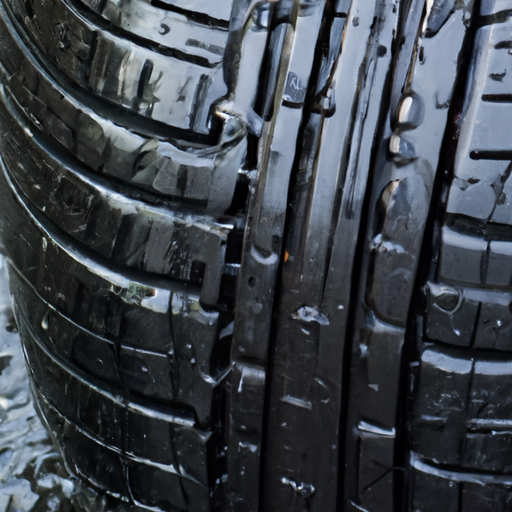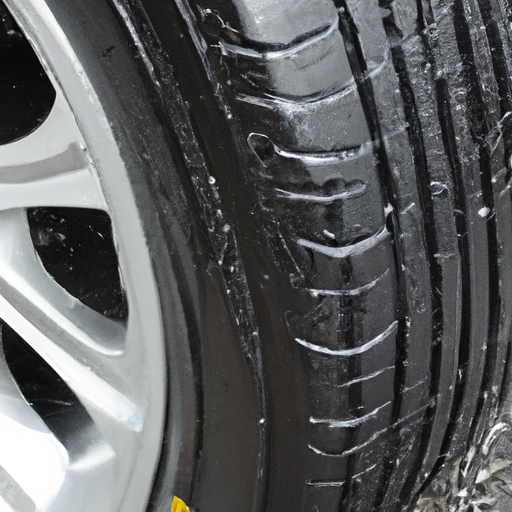Imagine you’re driving down the road on a beautiful summer day, feeling the wind in your hair and the warmth of the sun on your skin. Suddenly, the car in front of you brakes suddenly, and you quickly step on the brake pedal. But have you ever wondered how the type of tires you have on your car could impact your braking distance? In this article, we will explore how summer tires influence braking distances, providing you with valuable insights to ensure your safety on the road. So, let’s buckle up and discover the importance of having the right tires for the season!
1. Tire Composition
When it comes to understanding how tires affect braking distances, it’s important to first consider their composition. Tires are made up of various components, and two key aspects to note are the rubber compound and the tread pattern.
1.1 Rubber Compound
The rubber compound used in the construction of tires plays a significant role in braking performance. Summer tires are designed with a rubber compound that is optimized for warm weather conditions. This unique compound allows for enhanced grip on the road, resulting in improved braking capabilities. On the other hand, all-season tires are engineered with a rubber compound that is more versatile, providing adequate performance in various weather conditions. While all-season tires may not offer the same level of braking performance as summer tires, they are designed to provide a balance between performance and longevity.
1.2 Tread Pattern
The tread pattern of a tire also plays a crucial role in braking performance. Summer tires typically have a tread pattern that is optimized for dry conditions, with larger contact patches and fewer grooves. This design allows for maximum contact with the road surface, resulting in enhanced grip and shorter stopping distances. All-season tires, on the other hand, have a tread pattern that is designed to perform well in both wet and dry conditions. They have smaller contact patches and deeper grooves to improve traction on wet surfaces, reducing the risk of hydroplaning. While the tread pattern of all-season tires may sacrifice some braking performance on dry roads compared to summer tires, it offers greater versatility in different driving conditions.
2. Braking Mechanisms
To understand the impact of tires on braking distances, it’s important to consider the braking mechanisms involved. Three key aspects to consider are friction, grip performance, and weight transfer.
2.1 Friction
Friction plays a fundamental role in braking. When you apply the brakes, the friction between the tires and the road surface helps to slow down and stop the vehicle. The rubber compound of the tire affects the friction generated, with summer tires typically providing higher levels of friction due to their specialized rubber compound. This increased friction allows for more effective braking, resulting in shorter stopping distances.
2.2 Grip Performance
Grip performance refers to the tire’s ability to maintain contact with the road surface during braking. This is influenced by both the rubber compound and the tread pattern of the tire. Summer tires, with their optimized rubber compound and tread pattern for dry conditions, generally offer superior grip performance compared to all-season tires. The larger contact patches and fewer grooves of summer tires allow for enhanced traction and grip, enabling the vehicle to brake more effectively.
2.3 Weight Transfer
During braking, weight is transferred from the rear of the vehicle to the front. This weight transfer affects the tire contact and grip on the road surface. The ability of the tires to maintain grip and control during this weight transfer is crucial for effective braking. Summer tires, with their enhanced grip and traction, can better handle weight transfer during braking, allowing for more controlled and efficient stopping.

3. Summer Tires vs All-Season Tires
When comparing summer tires and all-season tires in terms of braking performance, several factors come into play. These factors include differences in rubber compound, tread pattern variations, and temperature range.
3.1 Differences in Rubber Compound
Summer tires are specifically designed for warm weather conditions. Their rubber compound is engineered to provide maximum grip and performance in hot temperatures. This unique compound allows summer tires to maintain their elasticity on warm pavement, maximizing the contact with the road surface and improving braking efficiency. All-season tires, on the other hand, have a more versatile rubber compound. While they may not offer the same level of grip as summer tires in hot weather, they are designed to provide adequate performance in various conditions, including light snow and colder temperatures.
3.2 Tread Pattern Variations
The tread pattern of a tire affects its performance on both wet and dry surfaces. Summer tires have a tread pattern that is optimized for dry conditions, with larger contact patches and fewer grooves. This design allows for maximum grip and traction on dry roads, resulting in shorter stopping distances. All-season tires, on the other hand, have a tread pattern that is specifically designed to perform well in both wet and dry conditions. They have smaller contact patches and deeper grooves to improve traction on wet surfaces, reducing the risk of hydroplaning. While all-season tires may sacrifice some braking performance on dry roads compared to summer tires, they offer greater versatility in different driving conditions.
3.3 Temperature Range
Another factor to consider when comparing summer tires and all-season tires is the temperature range in which they perform optimally. Summer tires are designed to provide optimal performance in warm weather conditions, typically ranging from 45°F to 100°F (7°C to 38°C). These tires may become less effective and provide decreased braking performance in colder temperatures. On the other hand, all-season tires are engineered to provide adequate performance in a wider temperature range, making them suitable for various weather conditions and temperature fluctuations.
4. Dry Road Braking Performance
When it comes to braking on dry roads, summer tires have several advantages that contribute to enhanced performance.
4.1 Enhanced Grip on Warm Pavement
Summer tires are specifically designed with a rubber compound that maintains its elasticity on warm pavement. This allows for maximum grip and traction, resulting in more effective braking. The specialized rubber compound of summer tires allows them to provide superior grip on dry roads, enabling shorter stopping distances and improved control.
4.2 Shorter Stopping Distances
The combination of the rubber compound and tread pattern of summer tires results in shorter stopping distances on dry roads. The larger contact patches and fewer grooves provide maximum contact with the road surface, allowing for increased friction and improved braking performance. This means that you can brake more effectively with summer tires compared to all-season tires, resulting in shorter distances needed to bring your vehicle to a complete stop.

5. Wet Road Braking Performance
While summer tires excel in dry conditions, their performance on wet roads can be compromised. All-season tires offer advantages in terms of wet road braking performance.
5.1 Ability to Evacuate Water
One of the key factors that affects braking performance on wet roads is the tire’s ability to evacuate water. All-season tires have a specially designed tread pattern with smaller contact patches and deeper grooves. This allows them to effectively channel water away from the tire’s surface, reducing the risk of hydroplaning and maintaining consistent contact between the tire and the road. Summer tires, with their tread pattern optimized for dry conditions, may not be as efficient in evacuating water, which can negatively impact braking performance on wet surfaces.
5.2 Reduced Risk of Hydroplaning
Hydroplaning occurs when a layer of water builds up between the tires and the road surface, causing a loss of traction and control. The tread pattern of all-season tires helps to reduce the risk of hydroplaning by channeling water away from the tire’s surface, allowing for better contact with the road. This reduction in the risk of hydroplaning contributes to improved wet road braking performance compared to summer tires, which may be more prone to hydroplaning due to their specialized tread pattern for dry conditions.
5.3 Enhanced Traction on Wet Surfaces
All-season tires are designed to provide enhanced traction on wet surfaces. The smaller contact patches and deeper grooves in the tread pattern help to improve grip and traction, allowing for more effective braking. While summer tires may still offer reasonable performance on wet roads, the specialized tread pattern optimized for dry conditions may result in slightly longer stopping distances compared to all-season tires.
6. Temperature Sensitivity
Temperature sensitivity is another aspect that plays a role in braking performance, particularly for summer tires.
6.1 Optimal Performance in Warm Weather
Summer tires are specifically designed to perform optimally in warm weather conditions. The rubber compound used in summer tires maintains its elasticity on warm pavement, providing enhanced grip and traction. As the temperature rises, the rubber compound of summer tires becomes more adaptable, resulting in improved braking performance. This temperature sensitivity allows summer tires to offer their maximum braking capabilities when the weather is warm, making them an ideal choice for driving during the summer season.
6.2 Decreased Braking Performance in Cold Temperatures
On the other hand, summer tires may experience decreased braking performance in cold temperatures. The rubber compound used in summer tires is not designed to perform optimally in colder conditions, which can result in less grip and traction. As the temperature drops, the rubber compound of summer tires becomes stiffer, compromising their braking capabilities. It’s important to note that summer tires are not recommended for use in snowy and icy conditions, as their performance is significantly reduced in colder temperatures.

7. Braking Distance Comparison
When comparing braking distances between summer tires and all-season tires, several factors come into play. These factors include the differences in rubber compound, tread pattern, and the impact of speed.
7.1 Difference Between Summer Tires and All-Season Tires
Due to their optimized rubber compound and tread pattern, summer tires tend to have shorter braking distances compared to all-season tires on dry roads. The specialized rubber compound of summer tires provides maximum grip and traction, allowing for more effective braking. Additionally, the larger contact patches and fewer grooves of summer tires maximize the tire’s contact with the road surface, resulting in increased friction and improved braking performance. All-season tires, while offering versatility in different weather conditions, may sacrifice some braking performance on dry roads compared to summer tires.
7.2 Impact of Speed on Braking Distance
Another factor that significantly affects braking distance is the speed at which you are driving. The faster you are traveling, the longer it will take to bring your vehicle to a complete stop. This is because the kinetic energy of the moving vehicle is higher at higher speeds, requiring more braking force to overcome. Both summer tires and all-season tires will have longer braking distances at higher speeds compared to lower speeds. It’s important to always maintain a safe and appropriate speed, regardless of the type of tires you have, to ensure optimal braking performance and safety.
8. Importance of Proper Maintenance
Proper tire maintenance is essential for maximizing braking performance and safety. Three key aspects to consider for proper tire maintenance are regular tire inspections, proper inflation, and adequate tread depth.
8.1 Regular Tire Inspections
Performing regular tire inspections is crucial for identifying any signs of damage, wear, or uneven tread wear. Inspecting your tires regularly allows you to address any issues promptly, preventing further damage and ensuring optimal braking performance. Look out for any cuts, bulges, or uneven wear patterns on the tire’s surface, as these can negatively impact braking capabilities. If you notice any abnormalities during your tire inspections, it’s recommended to have them inspected by a professional tire technician.
8.2 Proper Inflation
Maintaining proper tire inflation is essential for safe and efficient braking. Underinflated tires can result in decreased braking performance, as they reduce the tire’s contact patch with the road surface, leading to reduced grip and traction. On the other hand, overinflated tires can cause the contact patch to shrink, negatively affecting braking performance and stability. It’s important to check your tire pressures regularly and ensure that they are inflated to the manufacturer’s recommended levels for optimal braking performance.
8.3 Adequate Tread Depth
The tread depth of your tires directly impacts their ability to maintain grip on the road surface during braking. Tires with inadequate tread depth can result in decreased traction and longer braking distances. It’s recommended to regularly measure the tread depth using a tread depth gauge and ensure that it meets the legal requirements in your area. Most regions require a minimum tread depth of 2/32 of an inch (1.6 mm). If your tires have worn beyond this limit, it’s crucial to replace them to maintain optimal braking performance and safety.

9. Consideration for Driving Conditions
Driving conditions play a significant role in determining the most appropriate type of tires for your vehicle. Two key driving conditions to consider are urban driving and highway driving.
9.1 Urban Driving
Urban driving often involves frequent stops, starts, and turns, requiring responsive braking capabilities. In urban environments, the most important consideration is how quickly you can bring your vehicle to a stop. Therefore, having tires with superior braking performance, such as summer tires, can be advantageous. Summer tires, with their enhanced grip and shorter stopping distances on dry roads, can provide optimal braking performance in urban driving scenarios. However, it’s important to consider the local climate and driving conditions. In areas where wet or cold conditions are common, all-season tires may be a more suitable choice for urban driving, as they offer reasonable performance in different weather conditions.
9.2 Highway Driving
Highway driving typically involves higher speeds and longer distances, requiring tires that can handle sustained performance and offer stability. All-season tires are a popular choice for highway driving due to their versatility and ability to perform well in various conditions. They offer good traction and grip on both dry and wet surfaces, providing a safe and comfortable driving experience. While summer tires may offer superior braking performance on dry roads, they may not provide the same level of performance in wet conditions. Therefore, if you frequently drive on highways with varying weather conditions, all-season tires would be a more suitable choice, offering a balance between performance and versatility.
10. Conclusion
In conclusion, the type of tires you choose for your vehicle can have a significant impact on braking distances and overall braking performance. Summer tires, with their specialized rubber compound and tread pattern optimized for warm and dry conditions, offer enhanced grip and shorter stopping distances on dry roads. However, they may experience decreased performance in colder temperatures and can be less effective on wet roads. All-season tires, on the other hand, provide good performance in both wet and dry conditions, making them suitable for various weather conditions. They may sacrifice some braking performance on dry roads compared to summer tires but offer greater versatility. It’s essential to consider your driving conditions, weather patterns, and specific needs when selecting the most suitable tires for your vehicle. Regular tire maintenance, including proper inflation and adequate tread depth, is crucial for ensuring optimal braking performance and safety. By understanding the composition, mechanics, and performance characteristics of tires, you can make an informed decision and enjoy a safer and more confident driving experience.


